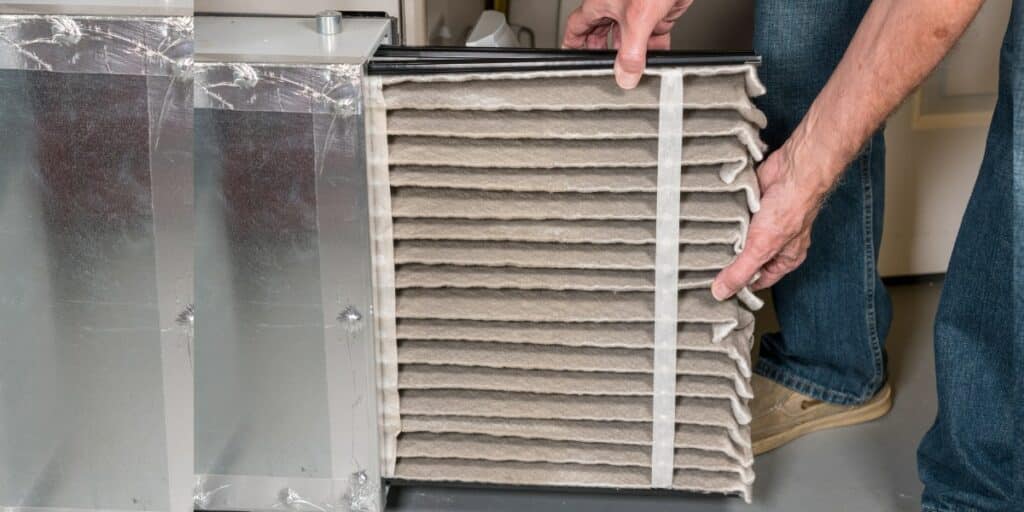One of the biggest complaints about forced air furnaces is poor airflow. Many people will have one room or even an entire floor in the home that doesn’t receive adequate airflow. As a result, that area will have drastically different temperatures when compared to the rest of the home. This comprehensive guide explores practical steps to improve your furnace’s airflow, ensuring peak performance without professional intervention.
You could crank the heat and hope the extra output covers the affected area. This is a terrible option because it will lead to outrageously high energy bills, overheating areas with adequate airflow, and there is a good chance the extra heat will never actually reach the target room.
Dealing with the airflow problem could also mean avoiding the cold room. However, if that room is a bedroom, chances are avoiding it isn’t an option.
What Could Cause an AirFlow Problem?
Several factors can contribute to poor airflow, and your home may struggle in one or more areas. It is important to know how the ductwork system in your home works because many airflow problems stem from problems with the ductwork.
The ductwork in your home is a system of metal, fiberglass, or wire and plastic tubes that transport the heat created by the furnace through the home.
Every room that receives heat will have a supply and return vent. The supply vent pushes air into the room, and the return vent sucks air back to the furnace to be heated. When there is an obstruction or a leak, airflow problems occur.
Let’s take a look at airflow problems caused by ductwork:
Obstruction at the vent
Many airflow problems stem from homeowners placing their furniture or other household items too close to or on top of a vent in the home.
Make sure every vent has adequate breathing room so that it can disperse air freely. Also, many people don’t realize that the vents can be opened or closed. A technician can skillfully adjust the vent openings around the home to maximize airflow.
Obstruction in the duct
Dirty ductwork can increase air friction, which decreases airflow. If the ductwork is especially clogged in one area of the home, this could be causing the airflow problem.
Also, some forms of ductwork have dampers that will direct airflow around the home. You may have a damper closed off to the affected room and not even know about it.
In both situations, you need the help of the technician. They can schedule a certified duct cleaning to cleanse your ductwork of any internal obstructions, and they can also set your dampers to increase airflow to the target area of the home.
Leak in the ductwork

Leaky ductwork is another big problem with central air systems. When there are gaps or poorly insulated areas of the ductwork, airflow is affected because the heated air escapes before it reaches the vent in the room.
You need to have the professionals examine your ductwork system and determine if sections need to be replaced or if you simply need to insulate the ductwork in certain areas.
Also, if you have very old ductwork in your home, you may want to consider replacing the entire system because it will hurt more than just the airflow in the home. It will also bog down the efficiency of the furnace and air conditioner.
How a Dirty Furnace and Filter Leads to Poor Airflow
Not all airflow problems are caused by ductwork. The furnace could also cause airflow problems when the unit is improperly maintained.
The furnace blower motor is the force that propels the air through the vents and into each room in your home. When this motor isn’t cared for, dirt and debris will build up on the fan blades. This could cause failure and decrease the motor’s ability to send air at a rapid speed through the ducts.
Therefore, the rooms furthest away from the furnace will suffer from poor airflow.
Also, when the air filter on the furnace is dirty, it slows down the air as it passes through on its way into the ductwork system.

If you do not change your filter regularly, this could be the source of your airflow problem. You must replace the filter at least every three months if not more, to increase airflow from the furnace.
If this still doesn’t help, make sure that the type of filter you are using isn’t restricting the flow. Thick pleated filters can often cause poor air flow in many systems.
Take care of these issues by scheduling your regular furnace tune-up. A professional HVAC technician will skillfully clean out your furnace and get it ready for this winter season.
Detailed Guide to DIY Airflow Improvement
Furnace Filters
Both paper-framed disposable and reusable filters require regular attention. Ensure proper installation, with the airflow arrow pointing in the correct direction. Clean reusable filters with warm water and let them dry completely before reinstallation.
Blower Motor
Clean the blower motor’s fan blades to remove dust build-up. Check and, if necessary, replace the belt to ensure it’s in good condition and properly aligned.
Vents
Regularly check all vents in your home to ensure they’re not blocked or covered by furniture, drapes, or other objects. Clean the vent grills to remove any accumulated dust or debris.
Ductwork
Look for any signs of damage, disconnection, or wear in your ductwork. Seal any gaps with duct tape or an adhesive caulk compound. If dust accumulation is significant, use a vacuum to clean the ducts.
Always wear goggles and a dust mask when inspecting or cleaning your ductwork.
Using Booster Fans to Improve Airflow
In cases where certain rooms are consistently colder, installing booster fans in the ductwork can enhance airflow to these areas, improving overall comfort.
Booster fans offer a simple yet effective solution to increase airflow from the furnace in areas of your home with inadequate heating. Here’s a closer look at how incorporating booster fans in your ductwork can resolve uneven heating issues and provide a more comfortable living environment.
They are particularly beneficial in situations where:
- Distant Rooms Are Colder: Homes with longer duct runs often experience a drop in airflow in rooms farthest from the furnace. Booster fans help by pushing the air further, ensuring these distant areas receive adequate heating.
- Complex Ductwork Designs: In homes with intricate ductwork designs, certain sections may not receive enough airflow due to the complexity of the path. A booster fan strategically placed can overcome this challenge.
The key to effectively using booster fans is placing them in the correct section of your ductwork. Typically, they are installed in the duct line, leading to the room(s) not receiving sufficient airflow.
While a handy homeowner can install a booster fan, it’s generally recommended to have this done by a professional. They can determine the most effective placement and ensure the fan is properly integrated into your HVAC system.
A booster fan might seem like a straightforward solution when enhancing your home’s airflow, especially in consistently colder rooms. However, it’s crucial to understand that while booster fans can temporarily improve airflow, their necessity often points to underlying issues in your ductwork that require attention from an HVAC professional.
Can adjusting the fan speed on my furnace improve airflow?
Increasing the fan speed can improve airflow, but ensuring your furnace can handle the adjustment without overloading is essential.
Some furnaces allow adjustments to the fan speed. Increasing the speed can improve airflow, especially in larger homes or those with longer duct runs.
By understanding and addressing the common causes of low airflow in your home’s heating system, you can significantly improve the efficiency and effectiveness of your furnace. Regular maintenance, including filter management, ductwork inspection, and blower motor care, can lead to a more comfortable, warm, and energy-efficient home.






